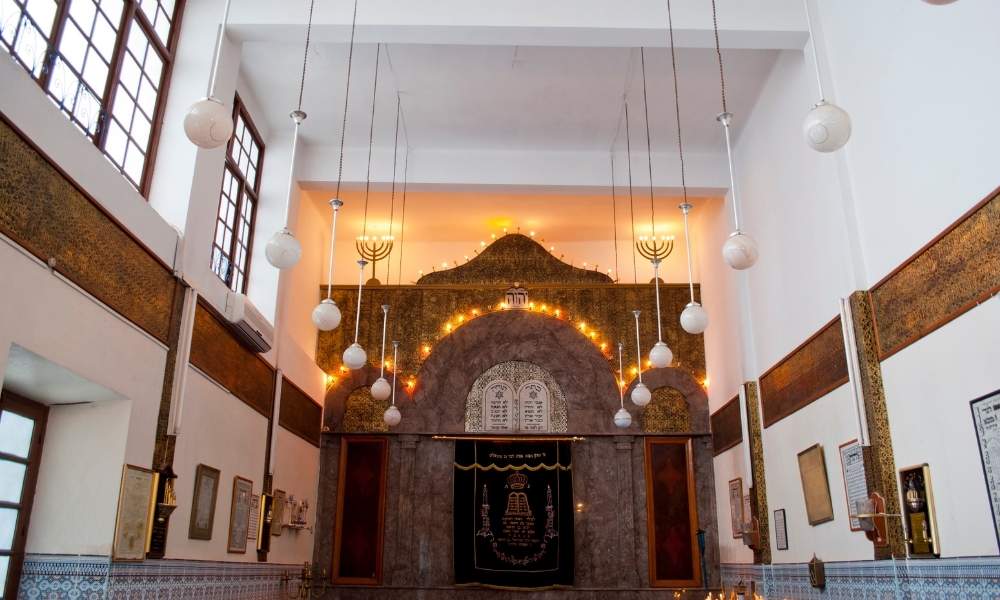Mellah’s can be found throughout Morocco and are commonly visited by tourists today.
Jewish history, beautiful mosaic artwork and bustling markets can be found within the walls of many mellahs.
While others have been left abandoned and have succumbed to ruin. Let’s explore what a Mellah is and how you can experience this part of Morocco’s history.
Table of Contents
What is a Mellah?
Located throughout Morocco you will find mellah’s, the historical living quarters of the Jewish people.
In major cities mellah’s were built close to the homes of political leaders and palaces, as the Jewish people played an important role in the economy.
In smaller communities though, Mallahs were created solely for the purpose of housing the Jewish people.
Surrounded by a fortified gateway, such as a wall or castle, mellah’s were created in part to protect the Jewish people from riots within the city.
Inside the walls of a mellah, a synagogue, kosher market and Jewish cemetery could be found and would serve the local Jewish community.
The Kosher Market would often be so popular that members throughout the city would come to purchase their wares.

A Brief History of the Mellah
In Northern Morocco, you will find Morocco’s second largest city, Fez. Which contains the ruins of Morocco’s first mellah.
In the early 1400’s, as a result of persecution, a massive wave of Jewish people immigrated to Morocco from Spain.
Due to the Jewish people’s loyalty to the Sultan and role within the Moroccan economy, the first mellah was built in 1438 in the city of Fez.
This idea spread throughout Morocco, hitting a peak in the 1500’s.
With many mellah’s being built in major cities, such as Rabat, Essaouira, Meknès and Marrakesh.
Once World War II hit, the vast majority of the Jewish population migrated to Israel and other safer and welcoming countries.
What is the origin of the name Mellah?
The name mellah or “salt” is suspected to have originated as a description of the area in Fez where the first mellah was located.
It is presumed that the land may have contained a saline water source or old salt warehouse. Either way the name was adopted and served as the label for all future mellah’s in Morocco.
As years went on though, the name mellah took on a negative connotation, as people thought the land may be cursed.
The History of the Marrakech Mellah
In Marrakesh you will find the ruins of the largest mellah in Morocco. Built in 1558, as per the authority of King Moulay Abdallah, the mellah was situated at the base of the royal palace.
Outside the massive structure a cemetery was established for the Jewish people and can be visited by tourists today.
Similar to other mellah’s the Marrakech mellah lost the vast majority of its Jewish population due to migration and other hardships.
Today, the mellah is mostly inhabited by Muslims and serves as a historical site visited by tourists from around the world.
Things to do in Marrakech Mellah
Mellah Market:
Known for its fragrant spice market, the Mellah Market is a great place to purchase souvenirs, clothing, dried fruit, aromatic soaps, as well as fruits and vegetables.
The colorful spices and dried herbs are beautifully displayed. With many visitors purchasing cumin, coriander, paprika, and chilli from this open market.
Please be careful and make sure to negotiate the price, as merchants have been known to overcharge.
The Lazama Synagogue:
Built in 1492, the gorgeous Lazama Synagogue is a popular tourist attraction, due to its rich history and beautiful interior.
Inside the walls are decorated with an intricate blue and white tiled mosaic artwork that is stunning to witness and commonly photographed.
You will also find a museum, explaining the Synagogues history and an open courtyard containing lush greenery and a water fountain.
Miara Jewish Cemetery:
Costing only 10DH to enter, the Miara Jewish Cemetery is best experienced with a guide to explain the cultural and historical significance of the area.
Visually the cemetery has been described as breath-taking, due in part to its unique white tombstones.
Located on 52 hectares, the cemetery is quite large and can take some time to traverse.
Uniquely the cemetery is also separated into sections, with children, women, men and important figures placed in separate areas.
Mellah’s are an important part of Jewish Moroccan history and culture. They were a place of refuge, but also a place of turmoil.
Although few Jewish individuals inhabit Mellah’s today, they serve as important historical sites for the Jewish people.